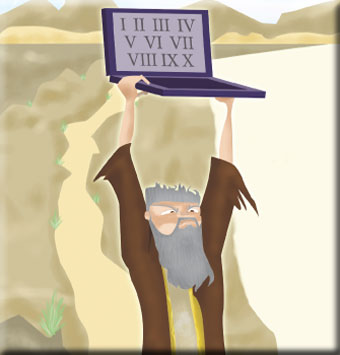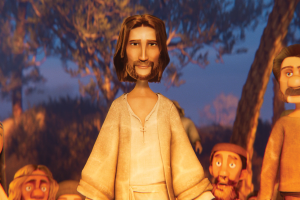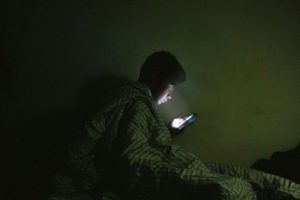Thou shalt not stop ordinary Catholics from using the Internet to speak their minds.
When Genevieve Kineke and a group of laywomen decided this year to celebrate the 20th anniversary of Mulieris Dignitatem, Pope John Paul II’s document on the dignity of women, she needed to get the word out. A mailing list, however, never even occurred to her.
"Someone had said, ‘Are we going to get a mailing list?' No, we don't use paper and stamps anymore, we just don't. We're an Internet generation," Kineke says.
Soon thereafter Kineke, an author and speaker on Catholic feminity, launched dignityofwomen.com, a website with contact information, an online version of the document, and updates on her movement to commemorate the 20th anniversary. Soon an e-mail listserv used by Kineke and her colleagues was aflame with rumors about this "lay group."
Who were these rabble rousers, promoting awareness of a Vatican document without any formal ties to the church? Were they qualified to speak on it?
"So many writers are used to the chain of command and say, ‘You guys are coloring outside of the lines,' and ‘Who are we to have the website?'" Kineke says. "It just looked like a bunch of rogue women."
Much attention has been paid to the ways technologies such as e-mail, text messaging, and new Web platforms have fundamentally altered the way we communicate. Less attention, however, has been paid to what this means for the church.
"Technology can be an incredibly powerful tool for the democratization or the participation of the faithful in decisions in the church," says Robert McClory, a former priest and professor emeritus of journalism at the Medill School of Journalism at Northwestern University.
McClory cites the work of Voice of the Faithful, the enormously influential lay group formed in the wake of the clergy sex abuse scandal.
"It started in Boston, and within two months they had 20,000 people on their list," McClory says. "That kind of thing never could have been done without e-mail."
Movements such as Kineke's-although operating independent of the hierarchy-stay well within accepted forms of lay participation. Others, however, may require the church to grow a little more flexible, while still others challenge the church's organizational structure outright.
Catholics can now exchange ideas on everything from raising children in the church to Catholic teaching without waiting for official support and organization. What's more, many can wield tremendous influence. The sum of initiatives enabled by new media technologies represents a potentially massive wave of participation by the laity.
Express yourself
In March 2007 Rob Kaiser, a Catholic who works in corporate America, stumbled upon an article discussing women's ability to organize efficiently online.
"Somebody in the press had bemoaned the fact there were a lot of Catholic moms' and Catholic women's sites, but they hadn't noticed any Catholic men's sites," says Kaiser. Thus Catholic Dads was born.
Catholic-dads.blogspot.com is known as a "group blog." Kaiser already maintained his own blog but decided to create a forum where Catholic dads could convene to discuss what it means to be Catholic in America.
"We the laypeople can get up there and talk about the hard issues. And we don't always agree, but we talk about them. And we learn about what the church teaches," Kaiser says.
Disagreement is what the Internet fosters so well. Discussion and debate drive bloggers to comment and re-comment on other bloggers' posts. Whereas catechism and pronouncements from bishops tend to be thought out, official, and final, much of the debate online will entertain arguments and ideas in conflict with the church's official line.
Bloggers, in other words, have the luxury of debating whether they can still support candidates despite their stances on abortion, or gathering the collective wisdom of Catholic parents on the appropriateness of giving their daughter the HPV vaccine.
David Gibson, author of The Coming Catholic Church: How the Faithful Are Shaping a New American Catholicism (HarperOne), argues that new media technologies facilitate communication among the laity on a level never before seen within the Catholic Church. Potentially this puts all bloggers on equal footing.
"All voices and all opinions are equalized in the world of the Web," says Gibson. "Cardinal O'Malley [of Boston] can blog on one thing or another, but that just makes him another blogger."
Kaiser expresses uncertainty about the level of authority he wields in the unruly blogosphere but enjoys having at least some small influence. "I know there are a lot of people reading it. I know when I read blogs it influences my thinking, so I know people are being influenced by what we're doing," Kaiser says. "And that's a good thing."
Catholic podcaster Lisa Johnston, who produces a weekly prayer podcast-a regularly updated series of audio and video segments available for download online-on Carmelite spirituality, sees the Internet as a wonderful medium to spread the spiritual gifts of her secular Carmelite order.
"At first when the community started doing this, we thought that we could do something for Catholic radio," Johnston says. "But in that way you are limited to a geographical location, but this way it can go where it needs to go."
Johnston speaks with excitement of an e-mail she received from a family living in Guam who listens every week. From their feedback she knows her message is carried to those who need it most.
This level of religious and spiritual sharing comes as no surprise to David Crumm, religion reporter for the Detroit Free Press, who has examined trends in how religion and faith shape lives in America. Citing the World Values Study, a collaborative effort by social scientists to gauge the moral and cultural values of different countries, Crumm highlights the three pervasive characteristics of American values.
"Compared with the rest of the world, Americans have an overwhelming desire for strong family and faith," Crumm says. "We also have an overwhelming desire for self-expression."
It is this third characteristic that makes Americans, Catholics included, naturally inclined to harness new media tools to share their experience of faith, religion, and spirituality.
Make new friends
In 1998, Glen Omvig owned a construction company in Oregon. Clare Wysocki was working as a nurse in Kuwait. They met online using an Internet dating site.
Last year they celebrated their eighth wedding anniversary, as well as the launch of their own online dating site for Catholics in New Zealand, CatholicMatchmaker.co.nz. Inspired by their desire to share their mutual experience of Catholicism with other young Catholics, the site not only pairs potential mates but also offers an additional service they've dubbed "mentoring."
"It's good to have nonjudgmental people to listen and tell you their story," Omvig says.
Omvig stresses that their mentoring program is not an alternative to official church marriage preparation programs. It's simply another, separate route for Catholics to learn about married life.
The desire to connect with fellow Catholics and discuss everything from dating to prayer to politics has led to a rise not only in Catholic dating sites but also Catholic social networking sites. CatholicMatch.com, for instance, expanded its offerings from its dating service to an additional social networking site, 4marks.com. Sites such as 4marks allow users to create a profile, share photos and video, read articles, take polls, and join discussions.
Church watchdogs
While all this communication creates places for new ideas and relationships to flourish, it can also create conflict.
Last August Jeff Baker, a 40-year-old police sergeant and blogger in Omaha, published a post calling attention to an upcoming speaker at Creighton University, a Jesuit school in Omaha. Titled "The Face of Death," the post detailed popular spiritual author Anne Lamott's pro-choice stance and her admission of participation in an assisted suicide. Baker then issued an open call to the blogosphere to petition the organizer of the event, the president of the university, and the archbishop of Omaha to uninvite Lamott.
Dozens of friends, fellow parishioners, and readers of Baker's blog, DefendUsinBattle.org, wrote Baker to inform him they would be writing Creighton.
Within 36 hours Lamott was officially uninvited. Father John Schlegel, president of Creighton University, stated that after a prayerful discernment of Lamott's latest work he decided to cancel Lamott's speech. Baker's blog post, he claims, did not influence his decision.
"If my blog and the publicity that it generated about Anne Lamott and Creighton had nothing to do with the president's decision, then we have pretty incredible timing," Baker says.
But the final result certainly did not create a forum where a different perspective could be heard. In some ways, new media tools helped to squash rather than expand the discussion of the issues around Lamott's writings and the ethical concerns about it.
"This new media can facilitate a mob mentality," Gibson says. "Whether you agree or disagree is beside the point-it does not always facilitate really considered charitable judgment. Bloggers can turn Internet surfers into peasants with pitchforks."
Baker himself sees blogs and the Internet as avenues for democracy as well as incredible tools for the mobilization of ordinary Catholics.
"I think that what is happening and what will continue to happen is a revitalization of the laity," Baker says.
McClory, author of As It Was in the Beginning: The Coming Democratization of the Catholic Church (Crossroad), views the blogosphere as a harbinger of democratization and revitalization.
"The blog is another extremely democratic innovation that permits amazing things to happen," McClory says. "If you believe the Holy Spirit is operative in the whole church, you might say the blog is an opening of the spirit to influence many people."
Others fear the Internet only facilitates the congregation of like-minded individuals. Various studies have concluded that only about 15 percent of political websites link to sites with opposing viewpoints. Sixty percent, on the other hand, link to sites with the same views.
If political sites are a fair indicator, the Catholic blogosphere probably follows the same pattern.
"On the downside of that I think the Internet and these new forms of communication can do to the church what has been done to society as a whole, further polarizing the church than it is now," Gibson says. "When your voice and our voice are indistinguishable from that of the people or the cardinal, you can get a cacophony of digital shouting. Is it really so much a democratizing of the church, or is it a megaphone given to the loudest complainers?"
The wild wild Web
After 20 years of work in youth ministry at the parish level, Sherry Raspa founded DisciplesNow.com, a site for young Catholics to congregate and read "appropriate" Catholic material. The site is now a part of an interfaith youth social networking site, YouthRoots.com, but Raspa says that parish ministers can control what their participants see.
"If there were a group leader that only wanted the group exposed to content tagged as ‘Catholic,' they can do that," she explains.
Parents appreciate safety and content filters on websites, but a Catholic label cannot stop the free flow of information on the Internet. If the content is out there, youth will most certainly find it.
"The genie is out of the bottle," Gibson says, and the church cannot control online content. "As recently as the middle of the last century, the bishops were gathering the index of forbidden books. In this new media culture they're not in control of what goes out there and what people read."
And while some bishops-such as Cardinal Sean O'Malley of the Archdiocese of Boston who writes his own blog-have embraced new media tools such as YouTube, blogging, and podcasting as a new means to communicate with the laity, these efforts amount to just another channel in a traditional communication structure.
The Web is collaborative, a two-way street, and the hierarchical structure of the Catholic Church stands in many ways in opposition to some of the peer-enabling communication tools of new media.
Meredith Gould, author of the forthcoming book The Word Made Fresh: Communicating Church and Faith Today (Morehouse Publishing), has spoken with churches across Christian faiths on how they communicate with their faithful. She found that despite the fact that Catholics enjoy more than 50 years of public statements on the use and abuse of media, the clergy tends to be woefully less sophisticated than their Episcopal or Lutheran counterparts.
"At Catholic parishes you can find Catholic websites that don't have links to the diocesan websites or the Vatican websites," Gould explains. "There's this very myopic, insular sense of what it means to be church."
Gould sees a great opportunity for the laity. "We are called by who has called us to communicate," she says. "We have a God of communication. We have a Lord of communication, the best communicator on the planet, in history. Jesus would probably have a blog if he were here today."
Crumm echoes that sentiment. The role of the institutional church in the new media landscape must be one of participant, not principal, Crumm says. New media turns communication into conversation, and if the institutional church seeks only to police the conversation, it may find itself relegated to the role of bystander.
"You can't control it, and at the root of it is powerful, positive energy that can be harvested for great good. It's like trying to clean up the Atlantic Ocean from New York harbor," Crumm says. "Learning to swim in the ocean is a far better course of action."
Honest to blog
When Glen and Clare Omvig decided to launch Catholic Matchmaker, their first task was to solicit the blessing of Archbishop John Dew of Wellington, New Zealand. Dew gave his support for the site.
"What we wanted from him was not only a blessing but also a commitment from the church," Omvig says. "That means that someone from the church is on the board."
That's a good first step, and a healthy way for a bishop to engage and encourage the efforts of the laity. The real question of how the church will adapt to the new media landscape, however, can only be answered in time.
Gibson, who contributes to Commonweal magazine's blog, dotCommonweal, laments the shouting matches that often dominate the blogosphere. He advocates a middle ground for the healthy debate of different viewpoints but warns that the church must engage in the dialogue as well.
"It's not right, left, or center; it's having a blog that opens the doors for dialogue. When do you allow something on a church-sponsored website that does not conform to the catechism?" he asks.
And while Gibson believes the largest obstacle to the hierarchy releasing its control on debates concerning church doctrine, practices, and Catholic catechism is fear, others believe the church has less to fear than one might think.
"Americans care deeply about their faith, so they are with you already," Crumm says. "But the thing they don't like is being told not to be self-expressive."
Never before have Catholics had access to the means to express themselves as they do now. Working together, lay Catholics and clergy can achieve a more democratic church, or at the very least a revitalized and engaged laity. Or the church can move to silence its members and curb the discussion percolating through new media channels. It certainly can't do both.
This article appeared in the July 2008 issue of U.S. Catholic (Vol. 73, No. 7, pages 23-27).













Add comment